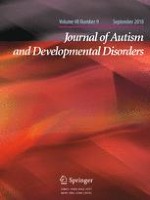19-04-2018 | Original Paper
The Relationship Between Sensorimotor and Handwriting Performance in Chinese Adolescents with Autism Spectrum Disorder
Gepubliceerd in: Journal of Autism and Developmental Disorders | Uitgave 9/2018
Log in om toegang te krijgenAbstract
Impaired sensorimotor control, as a common feature of autism spectrum disorder (ASD), could be a driving factor to handwriting problems. This study examined the Chinese and English handwriting and sensorimotor skills of 15 ASD and 174 typically developing Chinese adolescents. Participants with ASD had lower writing speed and poor manual dexterity (MD) than the typically developing participants. MD was a significant mediator between ASD and handwriting speed. Ground time and airtime represent the length of time when the pen touches the paper and is held in air, respectively. Participants with ASD who had better performance in MD showed shorter ground time in Chinese handwriting and shorter airtime in English handwriting. Training for adolescents with ASD on their MD may improve their handwriting performance.
